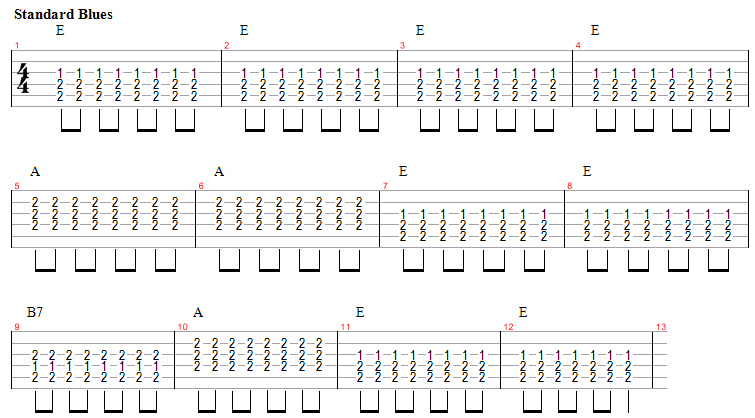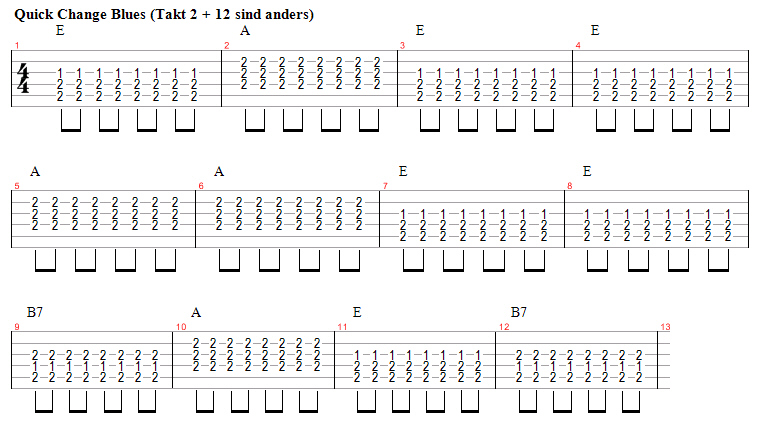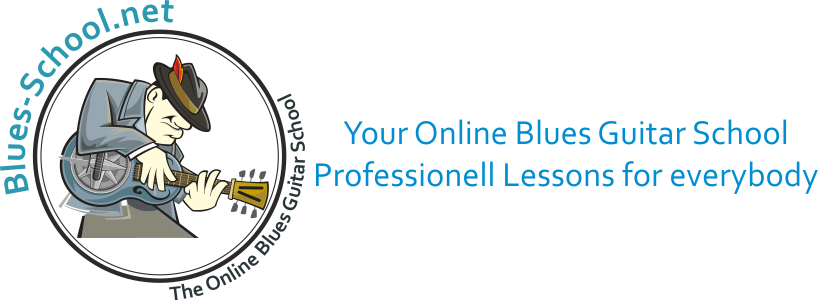Lesson 1 - The 12-Bar-Blues
Important
This first lesson is free for all. Here you can build you own impresson of the quality of the course. When you decide to become a member, you can pay the fee for the course with PayPal or as bank transfer to my German bank account. Then you´ll get your personal login and access to all lessons of this course! With your login dates you can learn at your own speed, at your own time, whenever you want to learn and to progess.
We start with THE foundation of the Blues, the 12-Bar-Blues. This lesson is very important because it´s the foundation for everything that follows. But don´t worry, we´ll start slowly and go on from there.
As you see, we use guitar tablature (short tab) for this course. If you don´t know how to read tablature, please read the lesson "Understanding Guitar Tab" in the Bonus Lesson section!
Basic Knowledge
The “normal“ 12-Bar-Blues consists of 3 chords, called the I, IV and V-Chord.
The I-Chord is always the key note (e.g. when we play a Blues in E, the I-Chord is an E) and we can count out the other two ones from this I-Chord on using the scale.
Here we have the scale: C D E F G A B (when we count further we´d start from the C again).
We already know the I-Chord (it´s always the note the song is in) and we count out the IV and V chord with our scale.
Just count out the I, IV and V chord with the scale. We start to count from the I-Chord, in our example it´s the E.
The Scale: C D E F G A B C D E F G A B C...
Start to count on the I-Chord of your 12-Bar-Blues (in the key of E, we´ll start at the E)
1. 2. 3. 4. 5.
E F G A B
You see: For a Blues in E, the I-Chord is an E, so that the IV and V chords would be an A and a B.
With this method we can always count out the I, IV and V chord with the scale!
Examples of several 12-Bar-Blues songs
Keytone C: I=C IV=F V=G
Keytone D: I=D IV=G V=A
Keytone E: I=E IV=A V=B
Keytone G: I=G IV=C V=D
Keytone A: I=A IV=D V=E
The 12-Bar-Blues
As we know, the normal 12-Bar-Blues has 12 Bars. And now we know which chords are used in it.
Now we need to know when to play each chord. Here we have an example in the key of E.
Bars: 1. 2. 3. 4. 5. 6. 7. 8. 9. 10. 11. 12.
Chord: I I I I IV IV I I V IV I I
E.g. E: E E E E A A E E B A E E
You see that we play 4 bars of the I-Chord, 2 bars of the IV-Chord, 2 bars of the I-Chord, then 1 bar of the V-Chord, 1 bar of the IV-Chord and two bars of the I-Chord. This structure is always the same in the “normal” 12-Bar-Blues. This progression is the same in every key you want to play a 12-Bar-Blues in.
But as you see, we play 2 bars of the I-Chord at the end and 4 bars of the I-Chord again at the beginning. This would be 6 bars of the same chord and that´d sound a little bit boring. That´s why we have the so-called “Quick-Change-Blues”.
The Quick Change Blues
In the Quick-Change-Blues we only change 2 bars, the second and the last, to bring a little bit more colour to our playing.
Bar : 1. 2. 3. 4. 5. 6. 7. 8. 9. 10. 11. 12.
Chord: I IV I I IV IV I I V IV I V
E.g. E: E A E E A A E E H A E B
Now we´re gonna start playing the 12-Bar-Blues in the key of E. We’ll start with the standard Blues first and play the Quick-Change-Blues later.
Important: Please download the mp3 drum loop at the end of this page to bring a good shuffle rhythm to your playing. It makes it more fun to practice and you have a Blues drum rhythm as foundation. Play both variations of the 12-Bar-Blues we´ve learned before and notice the difference in the sound.
Standard 12-Bar Blues in E

Quick Change Blues in E
![]() Listen to: Quick-Change-Blues in E
Listen to: Quick-Change-Blues in E

 Downloads
Downloads
PDF: Lesson 1 - The 12-Bar-Blues.pdf
mp3: Drum-Track Download this Drum Track and practice the 12-Bar-Blues with it.





